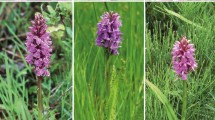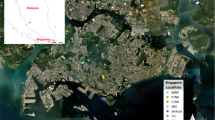Abstract
Salsola komarovi lljin is a herbaceous annual native to the sand dunes and beaches of Japan, northern China, Sakhalln and Korea. Starch-gel electrophoresis was conducted on leaves and stems collected from 300 plants in eight Korean populations. The mean number of alleles per locus (A p=1.51), mean expected heterozygosity (He p=0.116), and total genetic diversity (H T=0.279) were comparable with those for species with similar life history and ecological traits. A general conformance of genotype frequencies to Hardy-Weinberg expectations (meanF IS=−0.030) indicates thatS. komarovi is an outcrossing species. Slightly more than 20% of the genetic variation was found among populations (F ST=0.204). In addition, significant differences in allele frequency were detected between populations at all 11 polymorphic loci (P<0.001). Nei's genetic identities range from 0.885 to 0.985 with a mean of 0.942. However, indirect estimates of the number of migrant per generation (0.97, calculated fromF ST and 0.31, calculated from seven private alleles) indicate that the levels of gene flow is low among Korean populations. Although the species maintains a moderate level of genetic variation within populations, the small, isolated natural populations of the species have been severely destructed by human activities, particularly in summer season. If this is true, conservation efforts should be focused on those populations that currently maintain the most genetic diversity (e.g., populations of Cheju Island and coast of the southwestern Korean Peninsula).
Similar content being viewed by others
References
Barton, N.H. andSlatkin, M. 1986. A quasi-equilibrium theory of the distribution of rare alleles in a subdivided population. Heredity56: 409–415.
Bayer, R.J., 1988. Patterns of isozyme variation in western north AmericanAntennaria (Asteraceae: Inuleae). I. Sexual species of sect.Dioicae. Syst. Bot.13: 525–57.
Chung, M.G., 1994a. Allozyme diversity and population genetic structure inHosta jonesii (Liliaceae). Korean J. Genet.16: 147–156.
Chung, M.G. 1994b. Low levels of genetic diversity within populations ofHosta clausa (Liliaceae). Plant Species Biol.9: 177–182.
Chung, M.G. 1994c. Genetic structure in Korean populations ofHosta capitata (Liliaceae). J. Plant Biol.37: 277–284.
Chung, M.G. 1994d. Genetic variation and population structure in Korean endemic species: II.Hosta minor (Liliaceae). J. Plant Res.107: 377–383.
Chung, M.G. andChung, H.G. 1994. Allozyme diversity and population genetic structure in Korean endemic species: I.Hosta yingeri (Liliaceae). J. Plant Biol.37: 141–149.
Chung, M.G., Hamrick, J.L., Jones, S.B. andDerda, G.S. 1991. Isozyme variation within and among populations ofHosta (Liliaceae) in Korea. Syst. Bot.16: 667–684.
Chung, M.G. andKang, S.S. 1994. Genetic variation and population structure in Korean populations ofEurya japonica (Theaceae). Amer. J. Bot.81: 1077–1082.
Crawford, D.J., 1983. Phylogenetic and systematic inferences from electrophoretic studies.In S.D. Tanksely and T.J. Ortop, eds., Isozymes in Plant Breeding, Part A, Elsevier, Amsterdam, pp. 257–287.
Frankel, O.H. andSoulé, M.E. 1981. Conservation and Evolution. Cambridge University Press, Cambridge, MA.
Gottlieb, L.D., 1981. Electrophoretic evidence and plant populations. Prog. Phytochem.71: 1–45.
Gottlieb, L.D. 1982. Conservation and duplication of isozymes in plants. Science216: 373–380.
Hamrick, J.L. 1987. Gene flow and distribution of genetic variation in plant populations.In K. Urbanska, ed., Differentiation Patterns in Higher Plants, Academic Press, New York, NY, pp. 53–67.
Hamrick, J.L. andGodt, M.J.W. 1989. Allozyme diversity in plant species.In A.H.D. Brown, M.T. Clegg, A.L. Kahler, and B.S. Weir, eds., Plant Population Genetics, Breeding and Genetic Resources, Sinauer, Sunderland, MA, pp. 43–63.
Hamrick, J.L., Godt, M.J.W., Murawski, D.A. andLoveless, M.D. 1991. Correlations between species traits and allozyme diversity: Implications for conservation biology.In D.A. Falk and K.E. Holsinger, eds., Genetics and Conservation of Rare Plants, Oxford Univ. Press, New York, NY, pp. 76–86.
Hamrick, J.L., Godt, M.J.W. andSherman-Broyles, S.L. 1992. Factors influencing levels of genetic diversity in woody plant species. New Forests6: 95–124.
Haufler, C.H. 1985. Enzyme variability and modes of evolution inBommeria (Pteridaceae). Syst. Bot.10: 91–104.
Inoue, K. andKawahawa, T. 1990. Allozyme differentiation and genetic structure in island and mainland Japanese populations ofCampanula punctata (Campanulaceae). Amer. J. Bot.77: 1440–1448.
Jinno, T. 1956. On the relation between the chromosome numbers and the flora growing in the coast of inland sea in Japan. Jap. J. Genet.31: 147–150.
Karron, J.D. 1987. A comparison of levels of genetic polymorphism in geographically restricted and widespread plant congeners. Evol. Ecol.1: 47–58.
Kitamura, S. andMurata, G. 1987. Colored Illustration of Herbaceous Plants of Japan. Hoikusha Publ. Co., Ltd., Japan. (in Japanese).
Li, C.C. andHorvitz, D.G. 1953. Some methods of estimating the inbreeding coefficient. Amer. J. Human Genet.5: 107–117.
Loveless, M.D. andHamrick, J.L. 1984. Ecological determinants of genetic structure in plant populations. Ann. Rev. Ecol. Syst.15: 65–95.
Mitton, J.B., Linhart, Y.B., Sturgeon, K.B. andHamrick, J.L. 1979. Allozyme polymorphisms detected in mature needle tissue of ponderosa pine. J. Hered.70: 86–89.
Mun, H.T. 1984. On the plant succession of sand bars at the estuary of the Nagdong River. Ph. D. Dissertation, Seoul National University, Seoul, Korea. (in Korean with English summary)
Nei, M. 1972. Genetic distance between populations. Am. Nat.106: 28–292.
Nei, M. 1973. Analysis of gene diversity in subdivided populations. Proc. Natl. Acad. Sci. USA.70: 3321–3323.
Nei, M. 1977.F-statistics and analysis of gene diversity in subdivided populations. Ann. Human Genet.41: 225–233.
Nishikawa, T. 1985. Chromosome counts of flowering plants of Hokkaido (8). J. Hokkaido Univ. Sect. 2B.35: 97–111.
Radford, A.E., Ahles, H.E. andBell, C.R. 1983. Manual of the vascular Flora of the Carolinas. Univ. North Carolina Press, Chapel Hill, NC.
Richter, T.S., Soltis, P.S. andSoltis, D.E. 1994. Genetic variation within and among populations of the narrow endemic,Delphinium viridescens (Ranunculaceae). Amer. J. Bot.81: 1070–1076.
Rohlf, F.J. 1988. Numerical Taxonomy and Multivariate Analysis System. Exeter Publishing, Setauket, NY.
SAS Institute, Inc. 1982. SAS User's Guide: Statistics SAS Institute, Inc., Cary, NC.
Schiller, G., Conkle, M.T. andGrumwald, C. 1986. Isozyme variation among native stands and populations of aleppo pine in Israel. Israel J. Bot.35: 161–174.
Schonewald-Cox, C.M. 1983. Conclusions: guidelines to management: a beginning attempt.In C.M. Schonewald-Cox, S.M. Chambers, B. MacBride, and W.L. Thomas, eds., Genetics and Conservation: A Reference for Managing Wild Animal and Plant Populations, Benjamin/Cummings, Menlo Park, CA, pp. 414–445.
Slatkin, M. 1985. Rare alleles as indicators of gene flow. Evolution39: 53–65.
Soltis, D.E., Haufler, C.H., Darrow, D.C. andGastony, G.J. 1983. Starch gel electrophoresis of ferns: A compilation of grinding buffers, and staining schedules. Amer. Fern J.73: 9–27.
Soltis, P.S. andSoltis, D.E. 1991. Genetic variation in endemic and widespread plant species: Examples from Saxifragaceae andPolystichum (Dryopter-Idaceae). Aliso13: 215–223.
Soltis, P.S., Soltis, D.E., Tucker, T.L. andLang, F.A. 1992. Allozyme variability is absent in the narrow endemic,Bensoniella oregana (Saxifragaceae). Conser. Biol.6: 131–134.
Soulé, M.E. 1986. Conservation Biology: the Science of Scarcity and Diversity. Sinauer, Sunderland, MA.
Van Valden, L. 1965. Morphological variation and width of ecological niche. Am. Nat.99: 377–390.
Wayne, R.K., Gilbert, D.A., Lehman, N., Hansen, K., Eisenhawer, A., Girman, D., Peterson, R.O., Mech, L.D., Gogan, P.J.P., Seal, U.S. andKumenaker, R.J. 1991. Conservation genetics of the endangered Isle Royle Gray Wolf. Conser. Biol.5: 41–51.
Weeden, N.F. andWendel, J.F. 1989. Genetics of plant isozymes.In D.E. Soltis and P.S. Soltis, eds., Isozymes in Plant Biology, Dioscorides Press, Portland, OR, pp. 46–72.
Wolff, S.L. andJefferles, R.L. 1987. Morphological and isozyme variation inSalicornia europaea (s.l.) (Chenopodiaceae) in northeastern North America. Can. J. Bot.65: 1410–1419.
Workman, P.L. andNiswander, J.D. 1970. Population studies on southwestern Indian tribes. II. Local genetic differentiation in the Papago. Amer. J. Human Genet.22: 24–49.
Wright, S. 1922. Coefficients of inbreeding and relationship. Am. Nat.56: 330–338.
Wright, S. 1931. Evolution in Mendelian populations. Genetics16: 97–159.
Wright, S. 1951. The genetic structure of populations. Ann. Eugen.15: 313–354.
Wright, S. 1965. The interpretation of population structure byF-statistics with special regard to systems of mating. Evolution19: 395–420.
Yahara, T., Kawahara, T., Crawford, D.J., Ito, M. andWatanabe, K. 1989. Extensive gene duplications in diploidEupatorium (Asteraceae). Amer. J. Bot.76: 1247–1253.
Author information
Authors and Affiliations
Rights and permissions
About this article
Cite this article
Kim, S.T., Chung, M.G. Genetic variation and population structure in Korean populations of sand dune speciesSalsola komarovi (Chenopodiaceae). J. Plant Res. 108, 195–203 (1995). https://doi.org/10.1007/BF02344344
Received:
Accepted:
Issue Date:
DOI: https://doi.org/10.1007/BF02344344




